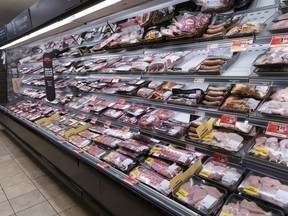Grocery Price Increases: Three Months Of Above-Average Inflation

Table of Contents
Understanding the Surge in Grocery Inflation
The recent spike in grocery costs isn't a single event but a confluence of factors contributing to this sustained period of high food inflation. Understanding these factors is crucial to grasping the current economic climate and its impact on consumers.
Factors Driving Up Food Prices
Several interconnected factors contribute to the rising grocery prices:
-
Increased Production Costs: The cost of producing food has skyrocketed. Fertilizers, a critical component of agriculture, have seen dramatic price increases due to global supply chain disruptions and energy costs. Fuel costs, essential for transportation and farm machinery, are also significantly higher. Furthermore, labor costs in agriculture and food processing have risen, adding to the overall production expense.
-
Supply Chain Disruptions and Transportation Costs: Global supply chain issues continue to plague the food industry. Delays in transporting goods, shortages of containers, and port congestion lead to higher transportation costs, ultimately impacting the price consumers pay at the supermarket. This is exacerbated by the ongoing war in Ukraine, a significant exporter of grains and other agricultural products.
-
Global Events Impacting Food Production and Trade: Global events, such as the war in Ukraine and extreme weather patterns (droughts, floods), significantly disrupt food production and trade. These disruptions limit supply and increase prices, especially for internationally traded commodities like wheat, corn, and sunflower oil.
-
Increased Demand Coupled with Reduced Supply: In some areas, increased consumer demand coupled with reduced supply due to adverse weather conditions or production challenges has led to even steeper price hikes. This imbalance between supply and demand further fuels grocery price increases.
-
Rising Energy Prices: The substantial increase in energy prices impacts every stage of the food supply chain, from farming and processing to transportation and refrigeration. This ripple effect significantly contributes to the overall cost of food.
Which Grocery Items Saw the Biggest Price Jumps?
The impact of rising grocery prices isn't uniform. Some items have experienced far more significant price increases than others.
- Eggs: Egg prices have soared due to avian flu outbreaks impacting poultry populations.
- Meat: Increased feed costs and labor shortages in the meat industry have led to higher meat prices.
- Dairy: Similar to meat, rising feed costs and increased energy costs in dairy farming have contributed to higher dairy product prices.
- Bread: Wheat prices, significantly impacted by the war in Ukraine, have driven up the cost of bread and other wheat-based products.
[Insert chart or graph here visually showing price increases for key items over the past three months. Clearly label axes and data sources.]
Regional variations also exist. Price increases might be more pronounced in certain areas due to localized factors, such as transportation costs or supply chain bottlenecks.
The Impact of Rising Grocery Prices on Consumers
The sustained increase in grocery costs is placing a considerable strain on household budgets, particularly for vulnerable populations.
Strain on Household Budgets
-
Impact on Low-Income Households and Food Insecurity: The rising cost of groceries disproportionately affects low-income households, forcing many to make difficult choices between food and other essential needs. This leads to increased food insecurity and potential health consequences.
-
Decreased Spending on Other Essential Items: As a larger portion of household income is dedicated to groceries, there's less money available for other essentials like housing, transportation, healthcare, and education.
-
Increased Reliance on Food Banks and Assistance Programs: Many families are turning to food banks and government assistance programs to supplement their grocery budgets, highlighting the severity of the situation.
Changes in Consumer Behavior
Rising grocery prices are prompting consumers to adapt their spending habits:
-
Buying Store Brands: Consumers are increasingly shifting towards store brands and cheaper alternatives to reduce their grocery bills.
-
Reducing Consumption: Many are cutting back on non-essential food items or reducing overall consumption to manage their budget.
-
Increased Meal Planning and Home Cooking: More people are planning meals carefully and cooking at home to save money compared to eating out.
-
Seeking Discounts and Deals: Consumers are actively searching for discounts, coupons, and loyalty programs to minimize grocery costs.
Looking Ahead: What Can We Expect?
Predicting future grocery price trends is challenging, but understanding potential factors can offer some insight.
Projections for Future Grocery Price Inflation
-
Expert Predictions and Economic Forecasts: Economic forecasts vary, but many experts predict that grocery price inflation will remain elevated in the near future, although the rate of increase might slow down.
-
Potential Mitigating Factors: Factors such as improved global supply chains, easing energy prices, and better harvests could help moderate future price increases.
-
The Role of Government Policies: Government policies, such as subsidies for farmers or programs to support low-income families, can play a crucial role in managing food prices and ensuring food security.
Strategies for Consumers to Manage Rising Costs
Consumers can employ several strategies to cope with high grocery prices:
-
Budgeting and Meal Planning: Creating a detailed grocery budget and planning meals ahead of time helps optimize spending.
-
Using Coupons and Loyalty Programs: Utilizing coupons, loyalty programs, and store sales can significantly reduce grocery bills.
-
Comparison Shopping: Comparing prices across different supermarkets and retailers can identify cost savings.
-
Buying in Bulk (when appropriate): Buying staple items in bulk can sometimes result in cost savings, but careful consideration of storage space and potential spoilage is necessary.
-
Growing Your Own Food: Growing fruits, vegetables, or herbs at home, even on a small scale, can supplement grocery purchases and reduce reliance on expensive supermarket produce.
Conclusion
The past three months have witnessed a concerning surge in grocery prices, driven by a complex interplay of factors ranging from increased production costs to global supply chain issues. This sustained period of above-average inflation has placed a significant strain on household budgets, forcing consumers to adapt their shopping habits and spending patterns. Understanding these factors is crucial to navigating this challenging economic environment. Stay informed about the latest developments regarding grocery price increases and inflation. Understanding the factors driving up food costs empowers you to make informed decisions and manage your grocery budget more effectively. Continue to monitor grocery price increases and adapt your strategies accordingly.

Featured Posts
-
 Penn Relays 2024 Allentown Boys Achieve Historic Sub 43 4x100m Finish
May 22, 2025
Penn Relays 2024 Allentown Boys Achieve Historic Sub 43 4x100m Finish
May 22, 2025 -
 Bwtshytynw Ydm 3 Laebyn Jdd Lmntkhb Amryka Lawl Mrt
May 22, 2025
Bwtshytynw Ydm 3 Laebyn Jdd Lmntkhb Amryka Lawl Mrt
May 22, 2025 -
 Thong Tin Moi Nhat Cao Toc Dong Nai Vung Tau Thong Xe 2 9
May 22, 2025
Thong Tin Moi Nhat Cao Toc Dong Nai Vung Tau Thong Xe 2 9
May 22, 2025 -
 Remembering Adam Ramey A Loss For The Dropout Kings And Their Fans
May 22, 2025
Remembering Adam Ramey A Loss For The Dropout Kings And Their Fans
May 22, 2025 -
 Understanding The Appeal Of The Goldbergs Nostalgia And Relatable Family Moments
May 22, 2025
Understanding The Appeal Of The Goldbergs Nostalgia And Relatable Family Moments
May 22, 2025
